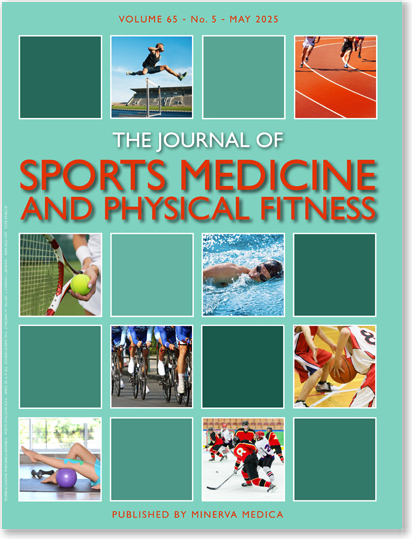 |
JOURNAL TOOLS |
| Publishing options |
| eTOC |
| To subscribe |
| Submit an article |
| Recommend to your librarian |
ARTICLE TOOLS |
| Reprints |
| Permissions |
| Share |

YOUR ACCOUNT
YOUR ORDERS
SHOPPING BASKET
Items: 0
Total amount: € 0,00
HOW TO ORDER
YOUR SUBSCRIPTIONS
YOUR ARTICLES
YOUR EBOOKS
COUPON
ACCESSIBILITY
ORIGINAL ARTICLES OTHER AREAS
(Biochemistry, Immunology, Kinanthropometry, Neurology, Neurophysiology, Ophtalmology, Pharmacology, Phlebology, etc.)
The Journal of Sports Medicine and Physical Fitness 2011 June;51(2).299-304
Copyright © 2011 EDIZIONI MINERVA MEDICA
language: English
Cold exposure increases exercise-induced oxidative stress
Martarelli D. 1, Cocchioni M. 1, Scuri S. 1, Spataro A. 2, Pompei P. 1 ✉
1 Department of Experimental Medicine and Public Health, University of Camerino, Camerino, Macerata, Italy 2 Department of Cardiology, National Institute of Sport Medicine, Rome, Italy
AIM.We determined the combined effects of cold and exercise on oxidative stress during submaximal exercise.
METHODS:Sixteen amateur male cyclists pedaled at a constant speed corresponding to 85% of maximal HR as determined in normal conditions. Eight athletes pedaled indoors at 23 °C while 8 athletes pedaled outdoors at a temperature of 4-6 °C. We then evaluated the levels of reactive oxygen metabolites and plasma levels of antioxidants after exercise.
RESULTS:Performing a physical task in cold conditions increased the free radical production, as demonstrated by the augmented levels of reactive oxygen metabolites and the concomitant decrease of plasma levels of antioxidants in outdoors cyclists as compared to indoors cyclists. The overall ANOVA and the post-hoc comparisons revealed a significant exercise and temperature effect. The mean level of reactive oxygen metabolites in athletes who exercised indoors was significantly lower than that of the outdoor athletes. Moreover, the outdoors group presented plasma levels of antioxidants significantly lower than those of the indoors group.
CONCLUSION: Since several sports are performed outdoors during the winter season, the increased risk of oxidative stress in cold conditions must be considered in these disciplines. Cyclists, football and rugby players, and runners are all affected by the elevation in oxygen radicals induced by cold and should take appropriate precautions, such as specific antioxidant integration.

 Login
Login Search
Search


